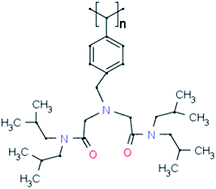Novel imino diacetamide styrene divinyl benzene resin for separation of 99molybdenum from irradiated uranium–aluminium alloy
Abstract
Imino diacetamide styrene divinyl benzene (IDAA SDVB) resin was synthesized and evaluated for separation of molybdenum (Mo) from simulated dissolver solution of irradiated uranium–aluminium alloy. Detailed studies were carried out to understand the influence of various parameters on sorption of Mo. The kinetics of Mo sorption is found to be fast and the kinetics data fit well to the pseudo-second order kinetic equation. Sorption of Mo is found to decrease with the increase of feed acidity. The loading capacity of resin is determined to be 30 mg g−1, the sorption isotherm data fit well to the Langmuir model. Batch sorption experiments with simulated dissolver solution showed quantitative uptake of Mo along with some co-extraction of iodine (I). Column runs have demonstrated that co-extracted ‘I’ could be scrubbed easily with solutions of feed acidity. Finally, sorbed Mo could be eluted with 3.0 M HNO3. XAFS and FT-IR studies of Mo sorbed on to IDAA SDVB resin have shown that Mo is sorbed in the +6 oxidation state (in the form of MoO42−), wherein the complex attains octahedral geometry with contribution from four oxygen atoms of the molybdate anion and two oxygen atoms of the amidic moiety of the imino-diacetamide ligand.


 Please wait while we load your content...
Please wait while we load your content...